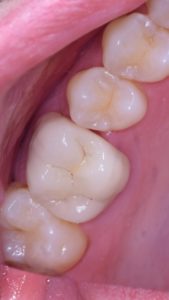Dental Prosthesis
Dentures can be fixed or removable. Their purpose is to reconstitute, strengthen or complete a tooth following a carious disease or fracture. Some dentures can replace a tooth.
-
Dental crown
-
Inlay / Onlay
-
Dental veneer
-
Dental bridge
-
Removable dental prosthesis
Dental crown
A crown is a prosthetic piece that completely covers the living or devitalized tooth following a very important decay (decay or fracture) and that it does not comprise any more enough healthy natural dental structure to support a composite resin or an Inlay/Onlay (partial restoration in ceramic).
There are several types: metallic, ceramic-metallic and ceramic-ceramic. Their indications will depend on the location and the expected aesthetic result.


The ceramic-metallic crown, as its name says, is composed of: a metal alloy (composing the inside of the crown) and a dental ceramic (on the outside). The alloy serves as a base (metallic skeleton) to support the ceramic that will cover it.
However, it will tend to look more opaque than normal teeth.
The ceramic-ceramic crown is a crown made entirely of ceramic, which gives it light transmission characteristics similar to natural teeth.
This type of crown will also have a better adaptation to the periodontium (gums).
Very often, a crown is made on a devitalized tooth. In some cases, an additional anchor called a post, pivot or inlay-core is added to the root of the tooth for better stability of the crown.
The crown will come on top of this anchor.



How is a crown placed?
Two sessions are required:
1/ Preparation of the tooth (or teeth) that will receive the crown: under local anesthesia, the tooth is prepared with a bur. Then, an impression of the tooth is taken, before closing the tooth with a temporary resin crown.
A dental technician will custom make the dental crown (based on the impression of the teeth, photos taken, and the shade of the patient’s teeth).
2/ Placement of the crown using a cement sealant. And finally the last adjustments of the occlusion so that the tooth is perfectly adapted to its neighbors during mastication.






